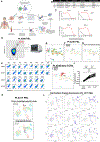Phenotypic signatures of circulating neoantigen-reactive CD8+ T cells in patients with metastatic cancers
- PMID: 38039963
- PMCID: PMC10843665
- DOI: 10.1016/j.ccell.2023.11.005
Phenotypic signatures of circulating neoantigen-reactive CD8+ T cells in patients with metastatic cancers
Abstract
Circulating T cells from peripheral blood (PBL) can provide a rich and noninvasive source for antitumor T cells. By single-cell transcriptomic profiling of 36 neoantigen-specific T cell clones from 6 metastatic cancer patients, we report the transcriptional and cell surface signatures of antitumor PBL-derived CD8+ T cells (NeoTCRPBL). Comparison of tumor-infiltrating lymphocyte (TIL)- and PBL-neoantigen-specific T cells revealed that NeoTCRPBL T cells are low in frequency and display less-dysfunctional memory phenotypes relative to their TIL counterparts. Analysis of 100 antitumor TCR clonotypes indicates that most NeoTCRPBL populations target the same neoantigens as TILs. However, NeoTCRPBL TCR repertoire is only partially shared with TIL. Prediction and testing of NeoTCRPBL signature-derived TCRs from PBL of 6 prospective patients demonstrate high enrichment of clonotypes targeting tumor mutations, a viral oncogene, and patient-derived tumor. Thus, the NeoTCRPBL signature provides an alternative source for identifying antitumor T cells from PBL of cancer patients, enabling immune monitoring and immunotherapies.
Keywords: CD8(+) T cells; T cell receptors; adoptive cell transfer; blood; neoantigens.
Copyright © 2023. Published by Elsevier Inc.
Conflict of interest statement
Declaration of interests R.Y., A.R.C., S.K., F.J.L. P.F.R., and S.A.R. are listed on a patent application (PCT/US2021/023225) that covers the use of NeoTCR(PBL) signature to identify antitumor TCRs.
Figures



References
-
- Thorsson V, Gibbs DL, Brown SD, Wolf D, Bortone DS, Ou Yang T-H, Porta-Pardo E, Gao GF, Plaisier CL, Eddy JA, et al. (2019). The Immune Landscape of Cancer. Immunity 51, 411–412. - PubMed
MeSH terms
Substances
Grants and funding
LinkOut - more resources
Full Text Sources
Medical
Molecular Biology Databases
Research Materials

